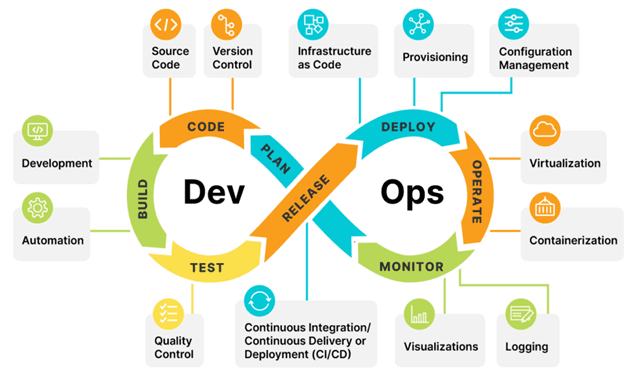Introduction
Stagnant, monolithic legacy methodologies are hard to innovate with. Modern services rely on many libraries, frameworks, and utilities that, when unified, deliver exceptional outcomes. Although proven and trusted by a huge community, the unification imposes management and maintenance complexities. A sound set of principles and strategies are required to overcome modern challenges. DevOps equips teams with principles and methodologies to develop, manage, and streamline the software development lifecycle.
True value extraction from DevOps depends on how well the team can control and visualize the operational flow. The dynamicity and repeatability factor enables control while monitoring factors enable visualization. The ability to capture and apply these functionalities defines the success metric of the DevOps team. Infrastructure as Code, Configuration as Code, and many other processes exist to enable the controlling factor. Monitoring as Code (MaC) has emerged as a comprehensive process for implementing configurable and reusable monitoring solutions.
What is Monitoring as Code?
A process enabling the ability to configure and manage monitoring resources in a repeatable manner is known as Monitoring as Code.
Monitoring as Code yields rewarding outcomes with increased agility, reliability, and efficiency. The flexibility of Monitoring as Code makes it a noteworthy process in the DevOps realm.
Why Monitoring as Code is Vital?
The conventional way of applying monitoring solutions entails manually configuring the processes using command-line interfaces (CLIs) or graphical user interfaces (GUIs). The manual factor of maintaining monitoring processes can very soon turn into a challenging and error-prone endeavor when requirements demand dynamically evolving sophisticated solutions.
Static and manual implementations are error-prone and pose a greater risk to security, efficiency, and team productivity. Monitoring as Code overpowers the bottlenecks while enabling comprehensive monitoring solution implementations. It uses a configurable approach to define the functionalities using various frameworks and languages. These functionalities can be reused, applied across services, automated, and improved as they progress.
What Can the DevOps Team Expect from Monitoring as Code?
Adopting Monitoring as Code can help DevOps teams achieve advanced objectives. Under the hood, Monitoring as Code enables industry-standard integrations and techniques to achieve exceptional observability. Teams handling complex infrastructures and distributed environments can expect the following capabilities using MaC:
- Integration with Infrastructure as Code for DRY automation and CI/CD implementations.
- Defining the monitoring specifications as code allows code management through version control systems.
- Repeatable implementations with scalability and security guarantees.
- Fine-grained controls over the infrastructure and application components.
- Ability to capture in-depth metrics and curate advanced analytics.
How Can Monitoring as Code Help the DevOps Team Succeed?
The main purpose and motive of DevOps teams is to build automated, efficient, and scalable solutions. They invest their efforts into building dynamic systems while heavily focusing on boosting performance and trimming operations costs. Succeeding in their work is critical to both the organizational and DevOps teams. Monitoring as Code is bundled with functionalities to optimize cost, performance, and security at a scale that fits into modern monitoring requirements. Let us review how Monitoring as Code can contribute to the DevOps team’s success:
Advanced Automation with Dynamically Configurable Components
Eliminating manual tasks trims down the unproductive capacity allocation. To thrive and innovate in the current marketplace, teams should focus on adapting and implementing operationally efficient solutions. DevOps teams can use Monitoring as Code to dynamically modify monitoring specifications and configurations in response to changes. Because of its adaptability, configurations can grow along with the complexity and needs of the system.
Overall, it helps improve the environment’s scalability, application deployments, or infrastructure management through automation. Uniformity and standardization can be achieved across environments through dynamically coded monitoring configurations. By creating reusable monitoring templates, DevOps teams can ensure consistency in monitoring configurations and lower the risk of configuration drifts or inconsistencies.
Efficiency and Performance Boosts
Compute-intensive applications integrated with multiple sources and modules exhibit poor responses concerning scalability and responsiveness. DevOps teams focus their time and energy on building and improving solutions and implementation to boost performance and efficiency.
Through optimizations, a resource under or overutilization can be eliminated, and monitoring infrastructures are kept operating at peak efficiency without sacrificing performance. DevOps teams can work well together, share code artifacts for monitoring, and use version control systems to properly manage changes. This more efficient way of working together improves communication, speeds up troubleshooting, and promotes a culture of continual development.
Resource and Cost Optimizations
Triangulating cost-intensive resources and applying better-yielding functionalities are two of the key responsibilities of DevOps teams. This never-ending task keeps getting complex when solutions become sophisticated. Generally, teams have to isolate usage patterns, latencies, bottlenecks, and many other factors manually to triangulate the cause.
The programmable nature of Monitoring as Code helps teams to match resources to actual usage and performance requirements dynamically to optimize monitoring expenses. To reduce costs and increase return on investment, teams can leverage existing cloud-native monitoring capabilities and adopt lifecycle management techniques to apply cost-effective monitoring solutions. Through Monitoring as Code, custom templates that trigger based on custom events and indicators can be generated, minimizing overhead while helping in fine-tuning costs.
Conclusion
DevOps has evolved exponentially over time, easing delivery and developers’ lives. Monitoring as Code has emerged as a game changer in enabling DevOps teams with practices and methodologies to implement comprehensive and repeatable monitoring solutions using code. It can help DevOps teams maintain consistency across infrastructure, apply scalable and reliable solutions, and help implement proactive optimization and CI/CD across the software delivery lifecycle. Monitoring Code as a whole helps DevOps teams to realize efficiency and performance improvements.
Follow Techdee for more!





